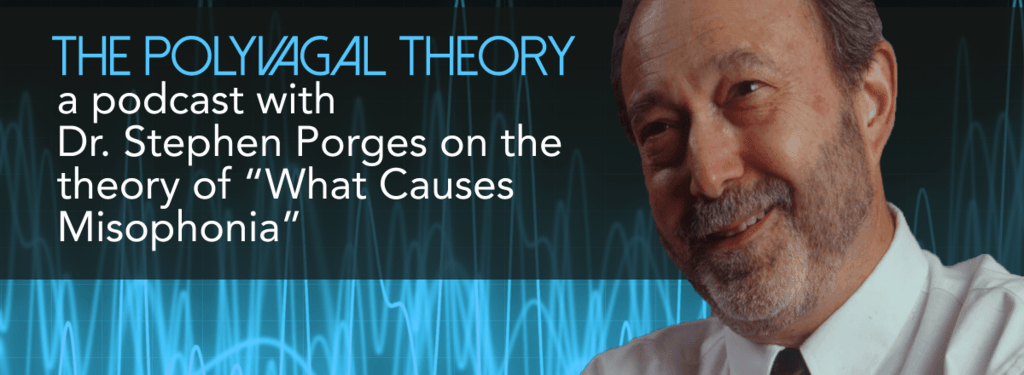
Since Misophonia is a new disorder, research may go several different ways. Dr. Stephen Porges, who proposed “the Polyvagal Theory”, has been studying the relationship between sounds and our reactions to them. Along-side the IMRN, Dr. Porges has been conducting research that is influenced by Misophonia.
Click here or the photo to learn more about Dr. Porges’ Theory and listen to his full podcast on our website, youtube, or the Apple Store.
The Polyvagal Theory (gr. ‘polus’, “‘many’” + ‘vagal’, “‘Vagus Nerve'”) was proposed and developed by Dr. Stephen Porges, Director of the Brain-Body Center at the University of Illinois at Chicago. The theory specifies two functionally distinct branches of the vagus, or tenth cranial nerve. The branches of the vagal nerve serve different evolutionary stress responses in mammals: the more primitive branch elicits immobilization behaviors (e.g., feigning death), whereas the more evolved branch is linked to social communication and self-soothing behaviors. These functions follow a phylogenetic hierarchy, where the most primitive systems are activated only when the more evolved structures fail. These neural pathways regulate autonomic state and the expression of emotional and social behavior. Thus, according to this theory, physiological state dictates the range of behavior and psychological experience.
The Polyvagal Theory introduced a new perspective relating autonomic function to behavior that included an appreciation of autonomic nervous system as a “system,” the identification of neural circuits involved in the regulation of autonomic state, and an interpretation of autonomic reactivity as adaptive within the context of the phylogeny of the vertebrate autonomic nervous system. The paper has two objectives: First, to provide an explicit statement of the theory; and second, to introduce the features of a polyvagal perspective. The polyvagal perspective emphasizes how an understanding of neurophysiological mechanisms and phylogenetic shifts in neural regulation, leads to different questions, paradigms, explanations, and conclusions regarding autonomic function in biobehavioral processes than peripheral models. Foremost, the polyvagal perspective emphasizes the importance of phylogenetic changes in the neural structures regulating the autonomic nervous system and how these phylogenetic shifts provide insights into the adaptive function and the neural regulation of the two vagal systems.
If you would like to read this study, you can find the preliminary results below.
Affective responses to the acoustic features of sounds from a Polyvagal Perspective
Our nervous system is continuously being stimulated by the acoustic environment in which we live. While we feel calm and safe while listening to some sounds, other sounds alert us to danger or life threat. Some responses to sounds are learned through associations with negative and positive experiences, while others are “hard-wired” into our nervous system. The acoustic features of sounds that trigger these hard-wired reactions has been described in the Polyvagal Theory (Porges, 2011; Porges & Lewis, 2009). Polyvagal Theory proposes that, prior to associative learning, subjective responses to sounds are neurophysiologically and anatomically dependent on features of the acoustic signal such as pitch and variations in pitch. Consistent with the theory, safety is signaled when the pitch of an acoustic signal is modulated (pitch varies across time) within a frequency band in which there are no very low or very high frequencies. The modulation in vocalizations is frequently called prosody and within the context of Polyvagal Theory is assumed to be the vocal conduit that humans use to express positive emotional states. Thus, a monotone signal lacks prosody and is not sufficient to signal safety. In this study, we examined how acoustic properties related to pitch modulation differ among body sounds, natural sounds, and music. In addition, we investigated how specific acoustic features relate to feelings of pleasure and arousal.
To view please click and go to full screen. Either at the bottom, or via the double arrows at top.
If you are looking for misophonia coping skills, you can go here to see coaching (worldwide) and here to see therapy (Canada) options with Shaylynn Hayes-Raymond. Shaylynn also offers both live and on-demand webinars for misophonia.

